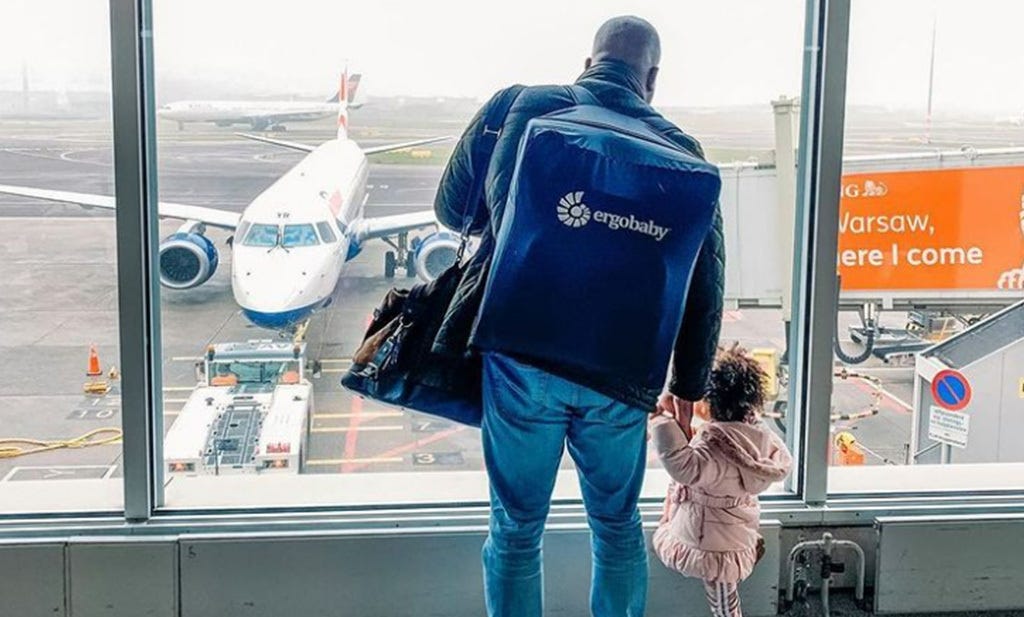
Yaaay, your first family holiday with your baby! Travelling with a baby is a whole new experience, and it can be pretty daunting, but we are here to help! With the right preparation you can limit the turbulence of your first flight with baby. We have summarised the most commonly asked questions and answers to give you all the information you need for flying with a baby.
When can I fly with my baby for the first time?
It's probably sooner than you think. According to Baby Center, most airlines will insist that your baby is at least two weeks old but depending where you live and where you are flying to there are no standard regulations, so it's best to check with your airline before you book. Some airlines may ask you to provide a fit-to-fly letter from your doctor if your baby is less than two weeks old.
If you gave birth by caesarean section, you may need to wait until after your six-week postnatal check-up before you take to the skies. Even then, you should only fly when your GP gives you the all clear.
It's usually easier to wait a few weeks before flying, to give you time to settle into life together. Also, your baby is more vulnerable to germs during their first month so you may not want to coop them up with dozens of strangers on an aeroplane. Waiting until after your child’s first vaccinations can also help you board the plane with greater peace of mind.
In addition to age, the stage of development and health of your baby are also important factors that determine whether your little one is ready to fly so check in with your paediatrician or GP if you have any specific concerns. This can also be useful for older children if they have a respiratory infection, stomach ache or earache.
What to pack when taking a baby on holiday?
From birth, your baby will need a passport for any trip where you leave the UK. Their passport is valid for five years, so it's worth bearing in mind if they have any older siblings that might need a renewal soon too.
For a relaxed trip, your hand luggage should include the following must-haves:
- Change bag with nappies, wet wipes, disposable nappy sacks. Carry a small wash bag so you don’t have to haul your entire hand luggage to the loo as there’s normally not much room in there!
- Spare clothes. Also bring clothes for you in case you spill their drink in a spot of turbulence, or in case air travel increases the amount they dribble.
- A bag for any dirty clothes
- Several sterilised dummies, if your baby uses them, sucking can help them stabilise the pressure in their ears during take-off and landing.
- Your baby's blanket as the smell can be comforting.
- Muslin cloths to wipe up accidents or spills.
- Enough formula milk if your baby is bottle fed and food if baby has started solids for the journey. Snacks can be one of the best ways to keep little ones occupied on a plane if they have started solids.
- Baby spoons and bibs if your baby is on solids.
- Toys and books to keep them occupied. We love mess-free colouring, reusable stickers and suction cup fidget spinners.
And find out about the hand luggage regulations in good time: Most airlines allow you to take a pram or pushchair with you free of charge.
Can you take baby food on a plane?
Gov.uk states that when travelling with a baby you’re allowed to take enough baby food, baby milk and sterilised water for the journey with you in your hand luggage. There is no legal limit to how much you can take however we always recommend checking with your airport before you travel as some have their own restrictions.
You can carry breast/chest milk in hand luggage even if you’re not travelling with a baby. You cannot carry frozen breast/chest milk in hand luggage.
Individual containers of breast/chest milk must hold no more than 2,000ml. Each container will need to be screened at the security point. Airport staff might need to open the containers to screen the liquids.
What you need to know when going through security with a baby.
To avoid long queues, some UK airports have special assistance and family lanes in security for departing families. When you’re travelling with young children in pushchairs, these dedicated lanes will give your family extra time and help to get through security. Keep an eye out for signs and ask the staff at check in if there is any special provision for families.
When going through security, all items are often scanned, including your hand luggage, compact stroller, baby carrier, baby car seat and children’s toys.
How do I travel through the airport with my baby?
There are various options here. The simplest is carrying your little one in their baby carrier. You can take your carrier on your flight to settle your baby or to have them close to you. In addition, the forward-facing carrying position is perfect for when you are sitting on the plane (not too long to avoid overstimulation) and with the baby carrier you have two hands free to go to the toilet, eat your inflight meal or look after other children. Some airports will also let you keep baby in the carrier as you walk through the scanners, perfect if they’re sleeping or overwhelmed, but it is at the airports discretion.


With a compact buggy like our Metro+ Deluxe, you can also push your little ones from check in right up to the stairs to the plane. Thanks to lie-flat recline, your baby can take a nap in between. The Metro+ is cabin friendly and fits into the hand luggage compartment of most planes so does not have to be handed over shortly before boarding the plane. Or alternately, you can pop it in a carry bag (available to purchase separately) and carry it on your back! Always check your airline requirements and their hand luggage guidelines.

A third transport option is the baby car seat. Even if you don't want to use your car seat on the flight itself, you may want to take your car seat on your trip. Most airlines will allow you to check a car seat into the hold for free in addition to your baggage allowance. This applies to toddler car seats and booster seats as well as infant carriers.
Do I need an airplane seat for my baby?
If your child is under 2 years old, you aren't legally required to purchase an airplane seat for them. Instead, you have the option of holding your baby or toddler in your lap. But it's much safer for your little one to be secured in an approved child restraint system in their own seat, no matter how short the journey is. On longer flights, when making your booking it is also possible to try and reserve a baby aeroplane cot (baby bassinet) for young babies.
What qualifies as an approved child restraint system?
If you buy an airplane seat for your baby or toddler, the safest way for them to fly is in a child restraint system. (Once they reach 40 pounds approx 18kgs, they can wear regular lap belts.)
There are two types of child restraint systems approved by the Federal Aviation Administration (FAA) :
- A car seat: Using a car seat on a plane is safer for your child and guarantees you'll have this necessary piece of baby gear once you're at your destination. Most car seats are approved for airline travel.
Top Tip: Check the car seat manual or look for a label on the car seat that says "This restraint is certified for use in motor vehicles and aircraft" to confirm.
On the plane, you'll install the car seat without the base, either rear- or forward-facing depending on your child's age.
- A CARES device: If you have an older baby or toddler and would prefer not to lug a convertible car seat onboard, AmSafe's Child Aviation Restraint System (CARES) device is a great alternative. This is a lightweight aviation restraint for children up to 40 inches (101cm) tall who weigh between 22 (10kg) and 44 (20kg) pounds.
Does airplane pressure affect baby?
Take-off and landing are not always pleasant, even for us grown-ups. But unlike us, babies can't equalise the pressure themselves yet. The best way to help your little one is by breast/chest feeding during take-off and landing. If you have chosen to bottle feed, you can use a bottle. A pacifier or dummy can help too if your little one uses one. For older children, a snack is ideal to help equalise the pressure. In case your child has a slight cold on the way there or catches a cold before the return flight, you should always have nasal drops with you. They can save you and your child a lot of pain. It is best to talk to your paediatrician about the dosage.
Can I change a nappy on board?
Let’s face it, changing nappies on a plane can be a tricky endeavour. Between tiny (or non-existent) changing tables and a poonami explosion during the worst turbulence, the challenges are real. Always come prepared, it’s totally possible to hack even the most challenging of airplane nappy changing situations.
To minimise the number of changes you need to make on any given flight, make sure to schedule a nappy change as close to boarding as possible in the airport before you board your flight. Airport lavatories have much larger changing stations and more room for you to operate.
Most toilets on planes are equipped with nappy-changing facilities. If you are unsure, ask the flight attendant beforehand.
Top tip: Airplane lavatories can be small and there is simply not room for you, your baby, and a large change bag. We recommend bringing a small removable change bag with you, including a few nappies, travel-size wipes, and some nappy cream if you’ll need it. Some airports with Boots chemists also allow you to do click and collect orders if there is anything you need but don’t want to lug all the way through the airport with you.
What if I am flying with a baby solo and need to go to the toilet myself?
Ask the flight attendant to keep a watchful eye over your baby so you can pop to the loo if they are happy to do so. Otherwise, strap on your baby carrier and take your little one with you.
We hope that with this knowledge you can start your holiday well equipped and relaxed.





















